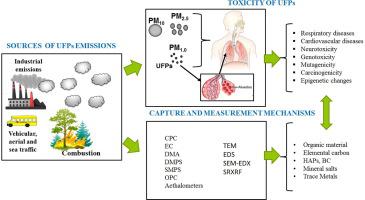Geoscience Frontiers ( IF 8.5 ) Pub Date : 2021-01-20 , DOI: 10.1016/j.gsf.2021.101147 Andrea L. Moreno-Ríos , Lesly Tejeda-Benítez , Ciro Bustillo-Lecompte

|
Air pollution by particulate matter (PM) is one of the main threats to human health, particularly in large cities where pollution levels are continually exceeded. According to their source of emission, geography, and local meteorology, the pollutant particles vary in size and composition. These particles are conditioned to the aerodynamic diameter and thus classified as coarse (2.5–10 μm), fine (0.1–2.5 μm), and ultrafine (<0.1 μm), where the degree of toxicity becomes greater for smaller particles. These particles can get into the lungs and translocate into vital organs due to their size, causing significant human health consequences. Besides, PM pollutants have been linked to respiratory conditions, genotoxic, mutagenic, and carcinogenic activity in human beings. This paper presents an overview of emission sources, physicochemical characteristics, collection and measurement methodologies, toxicity, and existing control mechanisms for ultrafine particles (UFPs) in the last fifteen years.
中文翻译:

超细颗粒物的来源、特征、毒性和控制:概述
颗粒物 (PM) 造成的空气污染是对人类健康的主要威胁之一,尤其是在污染水平不断超出的大城市。根据排放源、地理位置和当地气象,污染物颗粒的大小和成分各不相同。这些颗粒根据空气动力学直径进行调节,因此分为粗(2.5-10 μm)、细(0.1-2.5 μm)和超细(<0.1 μm),其中较小颗粒的毒性程度更大。由于它们的大小,这些颗粒可以进入肺部并转移到重要器官中,从而对人类健康造成重大影响。此外,PM 污染物与人类的呼吸系统疾病、遗传毒性、诱变和致癌活动有关。本文概述了排放源,










































 京公网安备 11010802027423号
京公网安备 11010802027423号